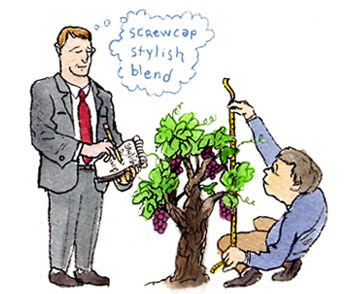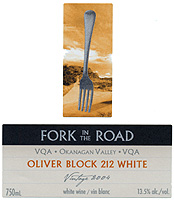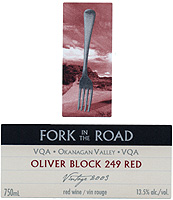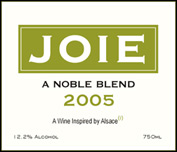

BC winemakers are tailoring interesting new wines that are highly fashionable not only in their taste, but also in their modern
packaging and catchy names.
British Columbia (Provincial Appellation)
The Rising Profile of Wine Blends in British Columbia
Many of the recent blended releases are premium wines, crafted to high standards and priced accordingly. Wineries are aiming these wines at sophisticated consumers who understand that, as good as single varietal wines are, blends can be more interesting.
by
John Schreiner
April 29, 2006
The irrepressible Walter Huber, owner of Hainle Estate Winery in the Okanagan Valley of British Columbia, has just released a blended white wine under his Deep Creek label that he calls ‘Wusiwug’ – what you see is what you get! A crisply dry aromatic white, it incorporates at least seven varietals in the blend. And it sells for $12.95 a bottle.
Wusiwug is part of a trend of releasing complex blends rather than varietal wines. However, Huber is leaving money on the table. Many of the recent blended releases are premium wines, crafted to high standards and priced accordingly. Wineries are aiming these wines at sophisticated consumers who understand that, as good as single varietal wines are, blends can be more interesting.
Of course, blended wines have long been produced in British Columbia but, typically, they were the throw-away wines at the bottom of the price scale. What’s new is the addition of blends at the upper range of prices, wines that are snapped up by restaurants and collectors.
The most recent of the major producers to release finely crafted blends is Mission Hill Family Estate Winery. The winery has created an entirely new label, Fork In The Road, as a vehicle for 1,500 cases each of a red wine and a white wine. Retailing at $24.99 a bottle (under screw cap), the wines are aimed primarily at the wine lists of select restaurants, with only modest quantities for sale at the cellar door and in the few private wine stores owned by Mark Anthony Wine Merchants, Mission Hill’s sister company.
The brand name refers to an intersection in one of Mission Hill’s major vineyards on Black Sage Road, south of Oliver. The fruit for the vines is drawn from this vineyard.
The white, Oliver Block 212 White 2004, is a blend that Mission Hill calls “unapologetically non-conformist.” There are four varieties in the blend: Chardonnay (62%), which was barrel-fermented and aged on the lees for eight months; Sémillon (22%); Pinot Gris (11%); and Viognier (5%).
The companion is Oliver Block 249 Red 2003, a blend of Merlot (50%), Syrah (35%) and Cabernet Sauvignon (15%).
See my tasting notes for reviews of these wines, both of which I scored 90 points. Most other wines mentioned here also are reviewed in the wine notes section.
Another winery on the same track is Tinhorn Creek. Under its premium Oldfield’s Collection label, the winery on June 1, 2006, will release 2Bench White 2005. Also under a screw cap – Tinhorn is switching entirely to screw cap closures – the wine sells for $22. Only 294 cases have been made.
This wine is a blend of Sémillon (47%), Chardonnay (25%), Sauvignon Blanc (21%) and Gewürztraminer (7%). Here again, the Chardonnay was fermented in new French oak, put through malolactic fermentation and left on the lees for two months. The other varieties were fermented individually in stainless steel. All the varieties were blended in February and bottled in March.
Further examples of complex blends:
Wusiwug is part of a trend of releasing complex blends rather than varietal wines. However, Huber is leaving money on the table. Many of the recent blended releases are premium wines, crafted to high standards and priced accordingly. Wineries are aiming these wines at sophisticated consumers who understand that, as good as single varietal wines are, blends can be more interesting.

Of course, blended wines have long been produced in British Columbia but, typically, they were the throw-away wines at the bottom of the price scale. What’s new is the addition of blends at the upper range of prices, wines that are snapped up by restaurants and collectors.
The most recent of the major producers to release finely crafted blends is Mission Hill Family Estate Winery. The winery has created an entirely new label, Fork In The Road, as a vehicle for 1,500 cases each of a red wine and a white wine. Retailing at $24.99 a bottle (under screw cap), the wines are aimed primarily at the wine lists of select restaurants, with only modest quantities for sale at the cellar door and in the few private wine stores owned by Mark Anthony Wine Merchants, Mission Hill’s sister company.
The brand name refers to an intersection in one of Mission Hill’s major vineyards on Black Sage Road, south of Oliver. The fruit for the vines is drawn from this vineyard.

The white, Oliver Block 212 White 2004, is a blend that Mission Hill calls “unapologetically non-conformist.” There are four varieties in the blend: Chardonnay (62%), which was barrel-fermented and aged on the lees for eight months; Sémillon (22%); Pinot Gris (11%); and Viognier (5%).
The companion is Oliver Block 249 Red 2003, a blend of Merlot (50%), Syrah (35%) and Cabernet Sauvignon (15%).
See my tasting notes for reviews of these wines, both of which I scored 90 points. Most other wines mentioned here also are reviewed in the wine notes section.
Another winery on the same track is Tinhorn Creek. Under its premium Oldfield’s Collection label, the winery on June 1, 2006, will release 2Bench White 2005. Also under a screw cap – Tinhorn is switching entirely to screw cap closures – the wine sells for $22. Only 294 cases have been made.
This wine is a blend of Sémillon (47%), Chardonnay (25%), Sauvignon Blanc (21%) and Gewürztraminer (7%). Here again, the Chardonnay was fermented in new French oak, put through malolactic fermentation and left on the lees for two months. The other varieties were fermented individually in stainless steel. All the varieties were blended in February and bottled in March.
Further examples of complex blends:
- A Noble Blend 2005 from Joie Wines and Farm Cooking School, priced at $20.40 a bottle, with a production of 980 cases. This is the winery’s second vintage of a white said to be inspired by the Edelzwicker wines of Alsace. The 2005 is a blend of Gewürztraminer (21%), Riesling (20%), Pinot Blanc (23%), Kerner (18%), Muscat (8%), Auxerrois (5%) and Ehrenfelser (5%). The lots were all fermented separately in stainless steel.
Once again, the winemaking was complex. “A touch of residual sugar was maintained by utilizing a yeast developed for sauternes that could be stopped easily to help maintain stability,” vintners Michael Dinn and Heidi Noble explain. “The wine was fine tuned at the final blending stage with a little bit of sweet reserve.” Dinn and Noble also chose a screw cap closure for this wine. - Pinnacle White 2004 ($25) from Sumac Ridge. This is a blend of Gewürztraminer (22%), Chardonnay (21%), Ehrenfelser (20%), Muscat (15%), Pinot Blanc (10%), Sauvignon Blanc (10%) and Sémillon (2%). This was the first release of a white Pinnacle, with a production of 250 cases. Since the 1997 vintage, the winery also has made a red Pinnacle (Merlot, Cabernet Sauvignon, Cabernet Franc and a dash of Syrah).
Sumac Ridge can lay claim to pioneering premium blends in the Okanagan. In the 1995 vintage, it was the first winery in Canada to produce a red Meritage, having secured the right to do so from the Meritage Association in California.
Under the Meritage rules, the wines must be blends of the varieties grown in Bordeaux. Typical red Meritage wines are blends of Cabernet Sauvignon, Cabernet Franc and Merlot; if the grapes are available, wineries may also use Petit Verdot, Malbec and Carmenère. White Meritage wines are blends of Sauvignon Blanc and Sémillon.
Many producers in BC now make Meritage wines. The exact mix in













